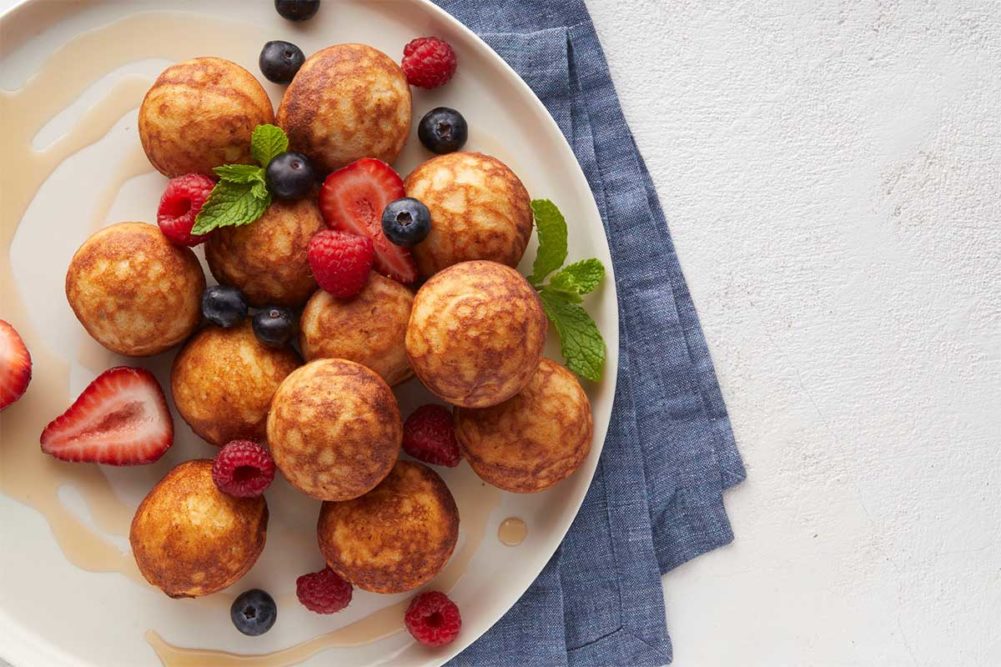While the age-old riddle, “Which came first: the chicken or the egg?” may spur a lively debate, the egg as an ingredient provides more than 20 distinct functional properties in baked goods. In many applications, bakers find that eggs play an integral, multi-functional role, all while keeping labels clean and simple.
“Egg ingredients play a vital role in the color, flavor, texture, structure and, yes, leavening of multiple baking applications and industry staples,” said Elisa Maloberti, manager, partner innovation and food safety, American Egg Board, Chicago. “In many bakery applications, eggs are often the principal moistener, structure builder and tenderizer.”
For example, eggs define quarkbällchen, German-style donut balls rolled in granulated sugar with a unique texture and taste. Some of this comes from the addition of quark, a silky fresh cheese similar to yogurt or sour cream, along with the egg proteins.
“The donut has a crispy style exterior and a soft, almost spongy interior,” said Rick Gizzi, sales director, Eurogerm USA, which recently rolled out a commercial mix for this sweet treat. “The flavor is a perfect blend of egg and vanilla, with the tartness of the cheese.”
There are situations where bakers may not want to use eggs. For example, despite their high-level of functionality, eggs are allergens and can experience price volatility. They also are not vegan, a claim growing in popularity among mainstream consumers. And some bakery applications, unlike the quarkbällchen, don’t rely so much on eggs for multiple functions. But for those that do, eggs in their various formats can provide a wealth of functionality.
Eggs appear to be simple: There’s a shell that encases white and yellow (yolk) portions. But their functionality is anything but, as the many compounds found in the white and yolk work in symbiotic combinations to achieve many functions, including adding nutrition to baked goods.
An average egg is three-fourths water. The rest is protein and fat, with about 1% ash, namely inorganic substances such as minerals. The white and yolk are often separated and used as individual ingredients by bakers, depending on the desired functionalities. Whites are about 88% water, and the rest is protein. Whites contain virtually no fat or ash, making them a protein powerhouse. Yolks, on the other hand, are about half water and one-third lipid. The rest is protein. The yolk is where you will find fat-soluble vitamins; important phospholipids, including choline for brain health and lecithin for cellular function; carotenoid pigments, including lutein and zeaxanthin for eye health; and minerals.
The yolk is also where you find cholesterol, as it is a type of lipid. And while cholesterol was taboo back in the 1980s and 1990s, subsequent scientific research has shown it is not the enemy. A study by the Harvard School of Public Health, published in The Journal of the American Medical Association in April 1999, found no significant link between eating eggs and developing heart disease among healthy individuals. Since then, health authorities have removed the daily upper limits for cholesterol intake, partly because the body needs cholesterol for cell development and structure, as well as digestion of fats.
The varied protein components of the white and yolk are responsible for imparting specific chemical, physical and sensory properties. The conditions of a batter or dough, such as pH, temperature and agitation, can modulate the functional properties of these proteins.
The major proteins in yolks are categorized as lipoproteins. These are proteins combined with fats, lecithin being the most prevalent lipoprotein. This combination of protein and lipid is responsible for the emulsifying properties of egg yolks.
Egg whites contain many proteins, including conalbumin, globulins, ovalbumin and ovomucin. These proteins enable egg whites to be whipped into a foam that can reach up to six to eight times greater volume than the unwhipped, liquid egg whites.
“It is these emulsification and foaming properties that deliver structure to baked goods and are the most difficult to duplicate with any single alternative ingredient,” Ms. Maloberti said. “Whole eggs, egg yolks and egg whites alone can increase volume, yet egg whites in particular are ideal as they have greater foaming capabilities than egg products containing yolks.
“The emulsion in the baking environment involves the integration of the fat phase into the water phase of batters and doughs. The more eggs, the more stable the emulsion,” she continued. “In a less stable emulsion, there would be a tendency for separation of the phases, with water going in one direction and fat in the other, affecting mouthfeel, texture, appearance and flavor, all of the essential qualities for a good cake, baked good, pastry or decadent food. A proper emulsion aids product porosity and volume, improves crumb softness through moisture management and contributes to the sensory eating experience, including mouthfeel.”
This article is an excerpt from the December 2021 issue of Baking & Snack. To read the entire feature on Eggs, click here.





